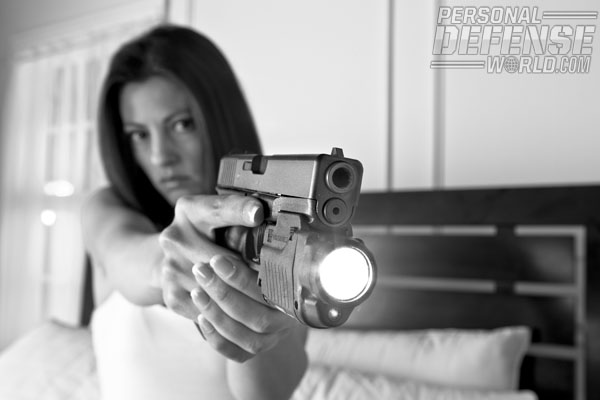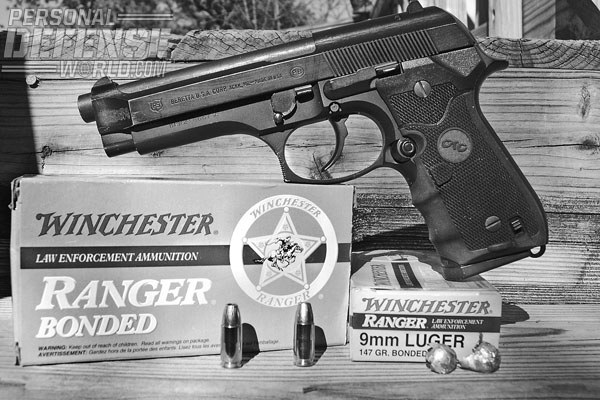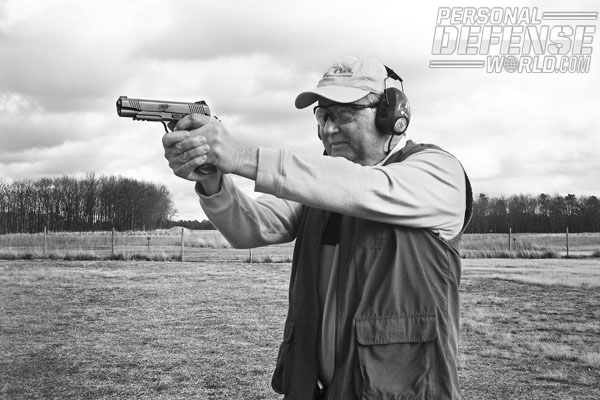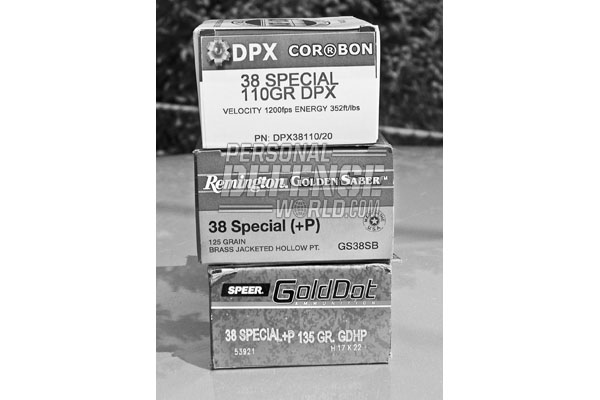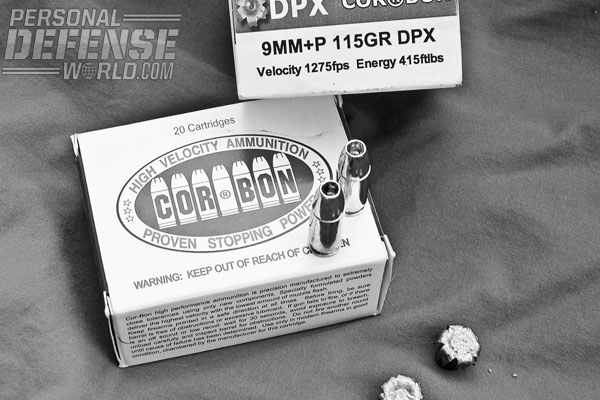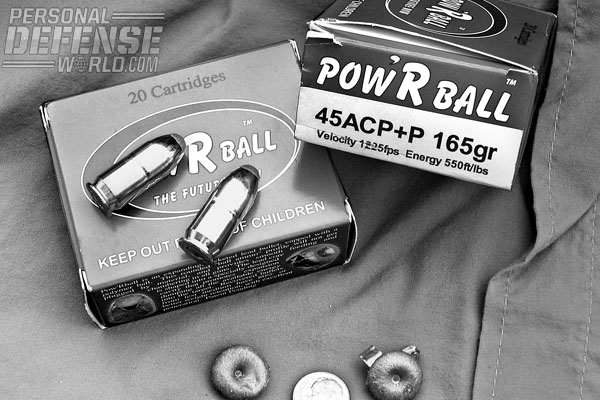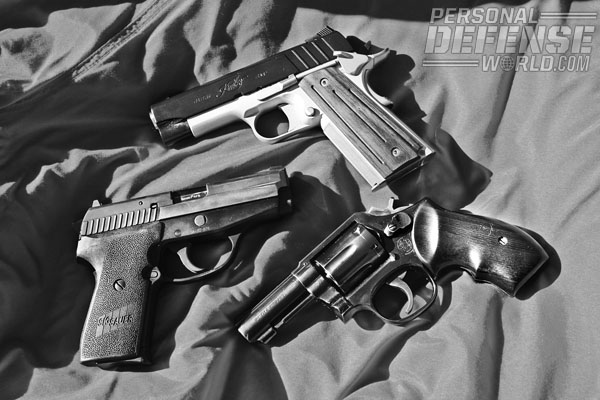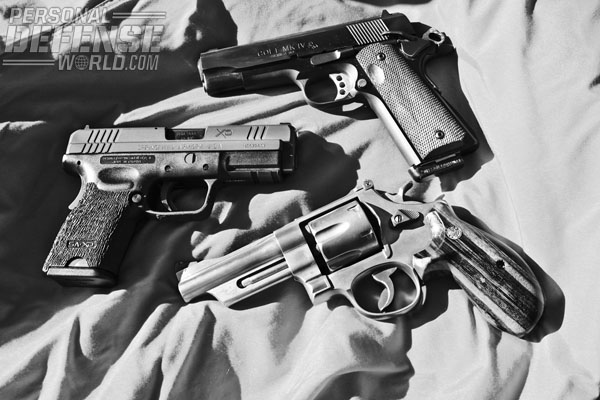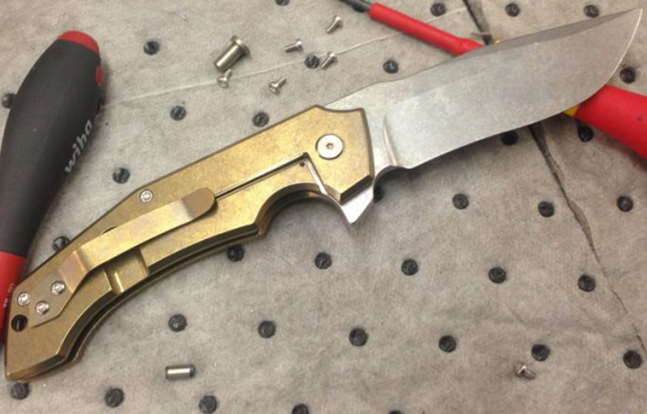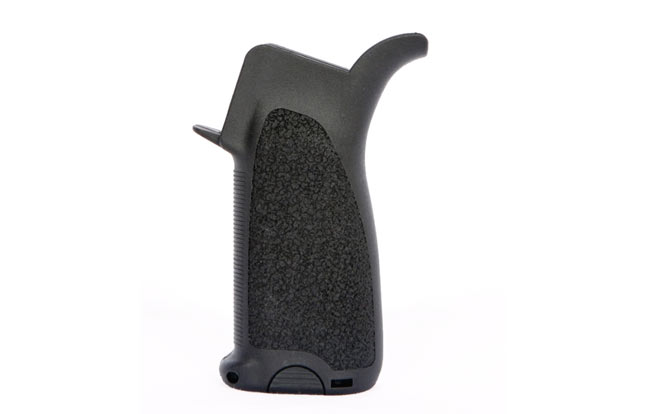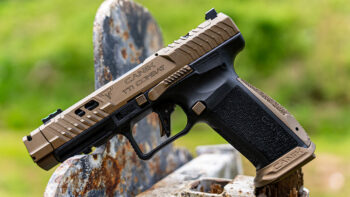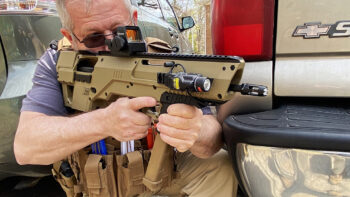Selecting a handgun/cartridge combination for self-defense can be an overwhelming decision. Should you select the optimum handgun and settle for its chambering, or would it be better to start with a proven, fight-stopping cartridge and wrap a handgun around it? A generation ago, choices were far more limited than now. Not only was the list of suitable handguns far more limited than the present, but cartridges like the .357 Sig, .40 S&W, 10mm, and .45 GAP didn’t even exist.
Today, many popular handgun platforms are available in a variety of chamberings, sizes and trigger actions. Let’s assume you have picked a handgun that best suits your needs. You now have to come to terms with the right chambering. The new high-performance cartridges certainly have appeal, as do the well-established classics.
For most defensive-minded shooters, performance is the key. The right handgun will give you a better likelihood of getting your shots on target, but when you get right down to it, the bullet of your chosen cartridge does the heavy lifting. Though upstart rounds like the .357 Sig and .40 S&W outperform the classics in almost every way on paper, are they really better?
Rounds that might be well suited for a full-size pistol can be very uncomfortable to shoot in a lightweight subcompact. Performance comes at a price, which usually means more recoil and muzzle flip. Before you holster up with the ballistic equivalent of a top fuel dragster, consider your skill level, frequency of practice, and the possibility that you may have to accurately fire multiple shot bursts and control your pistol with one hand.
Throughout my law enforcement career, I have carried handguns chambered for .38 Special, .357 Mag, 9mm, .40 S&W, .357 Sig and .45 ACP. More often than not, I was told what I could and could not carry. Since retirement, the decision as to what type of handgun and cartridge it is chambered for became mine alone.
For personal defense, I have opted to go with a trio of greybeard cartridges that have been around since Teddy Roosevelt was running the show. Al-though the ballistic tables illustrate that their raw horsepower does not equal that of some of the newer offerings, other criteria weigh heavily into my decision. High on my list is reliability in the types of handguns I prefer to carry. The fact that they all have proven track records isn’t entirely lost on me either.
.38 Special
Introduced in 1902 as a mate for the S&W Military & Police revolver, the .38 Special was considered a powerful cartridge in its day. It delivered significant boosts in performance over other mid-bores such as the .38 S&W and .38 LC, which were widely used at that time.
When revolvers were the law enforcement sidearm of choice, the .38 Special was king. True, many outfits went with the .357 Mag but, by and large, the .38 Special dominated the scene for over 80 years. It is unlikely any other metallic cartridge will surpass this record.
Nowadays, the .38 Special has a different role. Most states have now passed laws enabling armed citizens to carry a concealed handgun. Like police officers in the not so distant past, holders of CCW (Concealed Carry Weapon) permits have discovered that a small snub revolver that is with you all the time makes tremendous sense. When trouble arrives, a snub in the pocket beats a big gun left in the glove box.
From a small frame, short-barrel snub, the .38 Special is capable of a decent performance, provided you select the right load. Decent—not spectacular—but the .38 Special remains superior to cartridges like the .22 LR, .25 ACP, .32 ACP, as well as the .380 ACP. The short barrels of snub revolvers do play havoc with muzzle velocity and that, of course, has a direct impact on bullet expansion. Loads that perform like gangbusters in a 4-inch, .38 Special revolver often fail to expand in a snub.
The best defensive loads in .38 Special are loaded to “+P” or higher than standard pressure. Some favorite loads include Remington Golden Saber 125- grain JHP, Speer Gold Dot 135-grain JHP, and Winchester SXT 130-grain JHP. Although not a spectacular performer in gelatin, 158-grain lead semi-wadcutter hollow points for Federal, Remington and Winchester have posted good results in actual shootings. Another positive quality of the 158-grain LSWC-HP is that it generally shoots near point of aim in most fixed-sight revolvers.
Left to my own designs, I have come to favor CorBon’s 110-grain DPX load for the snub. This all-copper hollow point expands well, even when fired through a heavy clothing barrier.
Couldn’t we just ante up and go with a .357 Mag in that small-frame revolver? There are several different models of .357 snubs available, but they really don’t hold much appeal for me. Firing full house .357 Mags in the new, lightweight snubs is downright unpleasant. I’m not especially sensitive to recoil but these little guys represent a real challenge to shoot accurately at any kind of speed. For me, a well-engineered .38 Special +P load in a snub makes for the perfect hideout.
9mm Parabellum
The 9mm Parabellum remains the world’s standard in pistol cartridges. Introduced in 1902 for the Luger pistol, the Parabellum has been chambered for a wide range of pistols, submachine guns and even a few revolvers. Despite wide use and its near universal acceptance, its list of detractors is especially long.
Much of the negative opinion about the 9mm can be attributed to performance on the battlefield. In full metal jacket per-suasion, performance is indeed suspect and military ball rounds often pass right through a subject without incapacitating him. This experience has been observed most recently in Iraq and Afghanistan. When a well-designed expanding bullet is used, the 9mm Parabellum takes on an entirely new personality.
Premium “designer bullets” such as the Federal HST, Remington Golden Saber, Speer Gold Dot, and Winchester SXT all deliver the goods, and expand well even when fired through common barriers. This is especially true when bullets are driven at fairly high velocity. Personally, I like the mid-weight 124- to 127-grain JHPs, which all cruise through my chronograph screens at about 1,200 feet per second (fps).
Although many of my associates favor the heavy 147-grain 9mm subsonic loads, they just aren’t my cup of tea. When fired from compact and subcompact pistols, some loads will not break 900 fps and consequently, will not expand. If you do go the heavy bullet route in 9mm, the premium loads are well worth the additional expense. Federal’s new 147-grain HST load gallops along at about 50 to 75 fps faster than competitive offerings. It also expands well and penetrates to optimum levels in ballistic gelatin.
You can really have it your way with the 9mm Parabellum. One of the biggest advancements in pistol technology was the development of really small, subcompact 9mms like the Kahr and Kel-Tec, which effectively render the less capable .380 ACP obsolete. On the job, I carried a Glock pistol for nearly 20 years. As a personal protection piece, the compact Glock 19, holding 16 rounds of felon repellant, was a perfect fit for me. No matter what your preference in trigger action or size, there is a 9mm delivery system out there for you.
The 9mm is easy on both the shooter and the gun. Ammunition is readily available and cost is significantly less than other service calibers, an important factor when purchasing large amounts of ammunition for practice. If I had to choose a single handgun to issue to a large group of individuals of various sizes, skill levels and aptitudes, it would most certainly be chambered for the 9mm Parabellum. Its attributes far out-weigh the negatives, whether real or imagined, and I hardly feel under-gunned carrying the 9mm Parabellum.
.45 ACP
The .45 ACP was developed by John Browning in 1905 and adopted by the U.S. military with the 1911 pistol. This cartridge enjoys a good reputation as a stopper, although its capabilities are often exaggerated. I would submit that use of the .45 ACP by civilian law enforcement agencies and armed citizens is higher now than anytime in the past.
Although the .45 ACP has long been associated with the 1911, a wide range of different pistols is currently available from the major manufacturers. Despite some more recent innovations, I still utilize a 1911 as my heavy-duty carry gun.
If limited to ball ammunition, the .45 ACP clearly outperforms the 9mm Parabellum. This little fact was apparently overlooked when the 9mm replaced the .45 ACP as the service round of the U.S. Armed Forces. When non-ex-panding full metal jacket ammo is used, the greater frontal area of the .45 ACP gives it the edge.
For the cop or armed citizen, jacketed hollow points are the way to go. Modern DA pistols have not proven to be especially finicky feeders and will digest JHP loads without missing a beat. As much as I like the 1911, they sometimes prove temperamental in this regard and I would have to be absolutely certain that my pistol was reliable with my load of choice.
In my experience, the 185-grain and 230-grain hollow points deliver outstanding performance. Once again, loads that feature premium bullets are well worth the added expense. Although I favor +P loads in both .38 Special and 9mm, I don’t feel it’s necessary to “hot rod” the .45 ACP. In this cartridge, standard pressure loads with a good bullet will do just fine.
Felt recoil is a subjective quality and I don’t find the .45 ACP to be at all dis-turbing in either full- or Commander-size pistols. Polymer frame pistols of similar external dimensions are also relatively soft shooters. For a variety of reasons, I’ve never warmed up to the chopped and channeled .45 ACP subcompacts. My primary grievances include reliability and comfort, and if I require a small service caliber autopistol, I would select a 9mm.
Ammunition for the .45 ACP is readily available, but slightly more expensive than .38 Special or 9mm. Provided you go with a load featuring an expanding bullet, terminal performance is good and you will be well served indeed. Unlike some of the new high-performance cartridges, the moderate pressure .45 ACP will not beat your gun to death. It should keep running for quite some time.
Other Cartridges
If your pet cartridge was left off my list, don’t take it personally, it just doesn’t work for me. As a matter of fact, I really like the .387 Sig, .40 S&W, and even the 10mm. The problem is that the guns that fire them may not.
The .40 S&W was introduced in 1990 and quickly became a favorite of law enforcement. Locally, the .40 S&W is now far more popular than 9mm and street results are about as good as any to be expected from any handgun.
One of the initial marketing points of the .40 S&W was the fact that you could achieve “big bore” performance in a pistol the same size as a 9mm. But there is no free lunch. Most of the early .40 S&W pistols were merely 9mms with a bigger hole in the business end. Heavier bullets, higher slide velocities, and greater pressures have proven especially tough on these upsized 9mms. More than one law enforcement outfit I’m familiar with chose the .40 S&W only to switch back to 9mm because of durability and reliability issues.
Most 9mm JHPs have a feed-friendly ball-like ogive. On the other hand, a number of .40 S&W hollow points feature a bullet with a truncated cone profile. In some .40 S&W pistols, this has led to reliability problems. When my life is on the line, I want my pistol to work every time.
Much of the same can be said for pistols in .357 Sig. I do, however, find the wedge-shaped .357 Sig cartridge a bit more feed friendly than .40 S&W. The bark of the cartridge seems to be a few decibels louder, but felt recoil is slightly less.
I’ll confess to having a soft spot for the 10mm cartridge. By and large, the rest of the world does not and it has just about fallen off the radar screen. Pistols for the 10mm have typically been built on .45 ACP frames and with the exception of the Glock 29, are pretty fair-sized guns.
I have to give the .357 Mag an honor-able mention. In service-size revolvers, the .357 Mag is a handful but still manageable. The problem is that nobody seems to carry or use a service-size .357 Mag anymore. For self-defense, the Remington Golden Saber 125-grain JHP and the CorBon 125-grain DPX load gets my vote. As indicated earlier, the lightweight .357 snubs are best avoided. But if a full-size wheelgun races your motor, the .357 Mag is worthy of consideration.
History of Performance
A check of the ballistics table will reveal that recently introduced rounds such as the .357 Sig, .40 S&W and 10mm will outperform the classics in every way, but there is more to my formula for success than raw horsepower.
Long-term history and performance weigh heavily into my equation. It is generally agreed that pistols tend to be more reliable when chambered for the round they were designed for. The .45 ACP and the 1911 go together like bacon and eggs. John Browning’s timeless design becomes less reliable when other cartridges are utilized. With a rare exception, most modern pistols were initially chambered for the 9mm and will be at their best with this cartridge.
Left to my own designs, I still prefer a .38 Special snub for discreet carry. I like the fact I can carry a snub in the pocket or in an ankle holster where sand, lint or other debris can compromise the reliability of an autopistol. However, if you carry solely on the belt, a subcompact pistol is the better choice. The new crop of really small subcompacts is easier to shoot and holds more rounds than a snub. When chambered for the 9mm, these pistols will launch like-weight bullets faster than a .357 Mag snub.
I will continue to shoot my pistols in other calibers, but handguns in a .38 Special, 9mm, and .45 ACP will be my choice for self-defense. I like to keep my logistics simple and these classic cartridges help me simplify my plan. A knowledgeable acquaintance of mine often cites the “Wal-Mart factor” in selecting a defense handgun/cartridge combination. If you can’t find quality defensive ammunition behind the counter of your favorite discount store, you may want to reconsider your choice. The likelihood of shopping success with my trio of classics is better than with less-established offerings.
We should carry the biggest, most powerful gun we can shoot well and, if necessary, conceal. In many cases, it may be a small-frame snub chambered for the .38 Special. But no matter what, pick a cartridge that works well in your gun and has a good chance of shutting down a determined adversary. When addressing my particular needs and lifestyle, the .38 Special, 9mm Parabellum and .45 ACP have got it all covered.
To get this issue, visit /.













